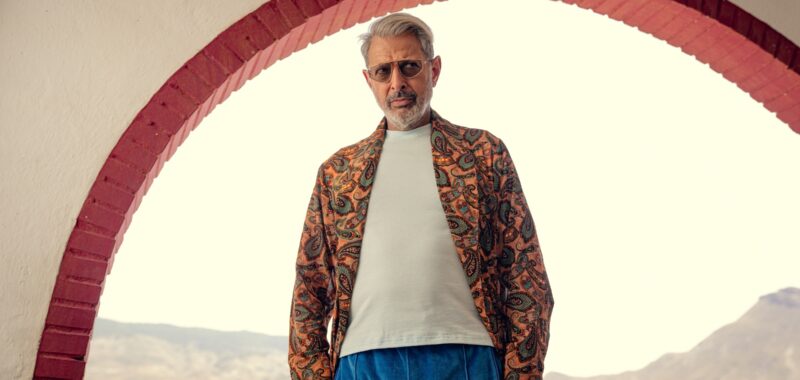In late August, Netflix released Kaos, a dark comedy reimagining Greek mythology for a modern audience. British actor and writer Charlie Covell, a self-professed mythology nerd, created and wrote the eight-episode series, relying on a heavy dose of high fashion and art history to bring the chaotic world of deities, mortals, and three-headed dogs to life.
Numerous visual references and cues help the audience read the series, especially the use of color — or lack thereof. The monochromatic, bureaucratized Underworld that Riddy (Aurora Perrineau) — a nickname for Eurydice, lover of Orpheus, whom he sought to rescue from death by charming the gods of the underworld with his music — enters after her death is devoid of color and life. And while the polychromatic nature of Kaos’s upper world may be jarring because we are so used to the whitewashing of antiquity, it cleverly captures the visual realities of the ancient world.
The color palette of the series is also an effective way of separating the plot lines: the neon brashness of Olympia; the bright, saturated hues of the streets of Heraklion; the drab beiges of the Trojans and their ghetto; the serious and professional navy and blacks of the royal family; and the monochrome Underworld are all visually distinct.

The costumes of Kaos also cleverly point us toward the personalities of the characters. Orpheus (Killian Scott), for instance, has a lyre tattoo; Persephone (Rakie Ayola), queen of both springtime and death, wears a flower print dress outside the Underworld; and Dionysus (Nabhaan Rizwan), god of wine and partying, appears at one point in a shirt printed with tigers, one of his signature motifs.
Other sartorial choices embody the essences of their characters rather than utilize specific iconography. The loungewear of Zeus — played by Jeff Goldblum — and the kaftans of Hera (Janet McTeer), for instance, do a great job of showing how little work they really do as gods, as does Poseidon’s poolwear. Meanwhile, Hades’s funeral-director costuming points to both his mythical role as god of the Underworld and the fact that, of the three brothers, he may be the only one really doing his job (ably supported by Persephone, whose costuming casts her as a very proficient receptionist). There are also lots of fashion choices that don’t map directly onto their mythological counterparts, but are gorgeous nonetheless — Riddy’s white sweetheart-neck Stella McCartney death-dress, a minimalist bridal look, is a highlight!

The show’s most successful characterization through costuming, however, is that of Dionysus, whose arc is very much worn in his clothes. One of the first shirts we see him in is printed with Francisco Goya’s c. 1798 “Witches Sabbath,” which depicts a coven of witches seated around Satan in an image of Bacchic excess. When he tells Orpheus how he can get Riddy back, he is wearing a Matrix-code-style shirt, perhaps nodding to the idea that Orpheus is having his eyes opened to the unseen possibilities of the world. Midway through the series, his shirts and jackets become more abstract in style, including one depicting Basquiat’s 1982 painting “Untitled (Tenant).” By the end of the series, Dionysus’s costuming is much more subdued, suggesting his desire and ability to take on more responsibility beyond his role as god of hedonism.
Art has long drawn from and popularized Greco-Roman mythology — in that sense, it has not left our visual imagination since antiquity. Although the extremely modern image of mythology presented by the show feels novel and unexpected, then, it might just be the most recent instantiation of a long-running phenomenon: The Pre-Raphaelites, for instance, shocked the establishment with their contemporary depictions of Greek mythology filtered through their own lens of Victorian visual culture.


Throughout, Kaos both exploits and disrupts this history. Some of the casting leans on now near-canonical popular images of mythical figures, including Ayola’s Persephone, which follows a slew of Black Persephones following Rosario Dawson’s take on the character in 2010’s Percy Jackson & the Olympians: The Lightning Thief. But Kaos also diverges from most re-imaginings of Greek myth in its graceful handling of difference and lack of need to justify it through mythology. Covell, for instance, casts disabled actors in roles that aren’t Hephaestus, who is clubfooted, or Oedipus, who is blind. The cinematography does justice to the range of skin tones; the costuming is sensitive to limb differences and trans bodies. Perhaps the most effective aspect of Kaos’s aesthetics, then, is that it ignores popular imagination to a large extent, insisting upon a mythical realm that is representative of the diversity and variety of real life.
It’s a shame to lose that representation, given Netflix’s recent announcement that the show will not be renewed. And we’ll miss the style moments — like Zeus’s dictatorial WFH fit — too.


Kaos (2024) is streaming on Netflix.

